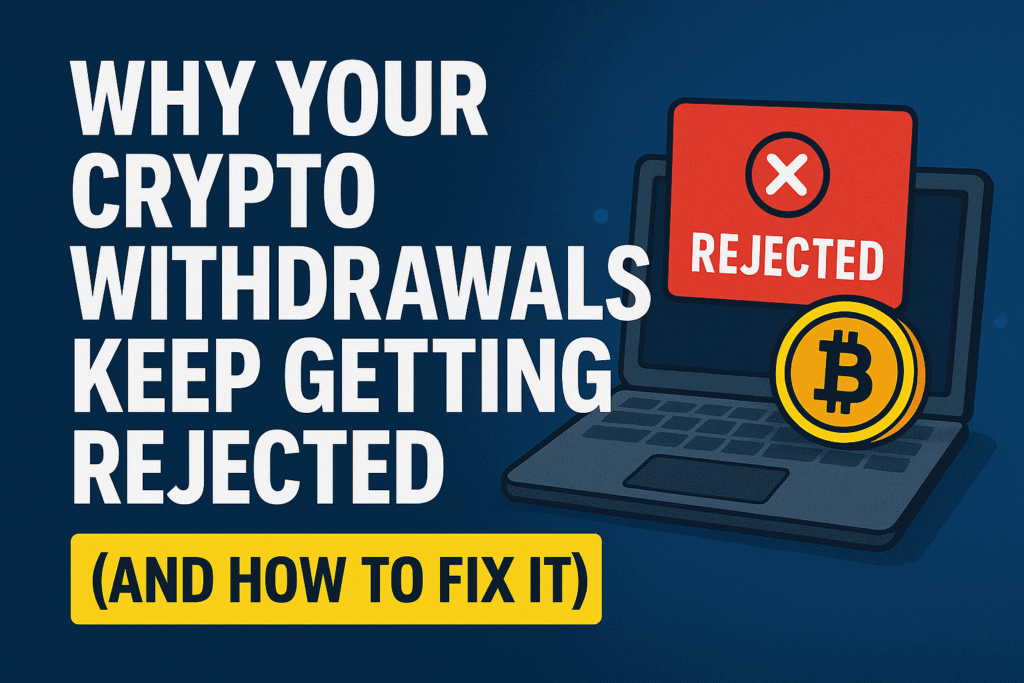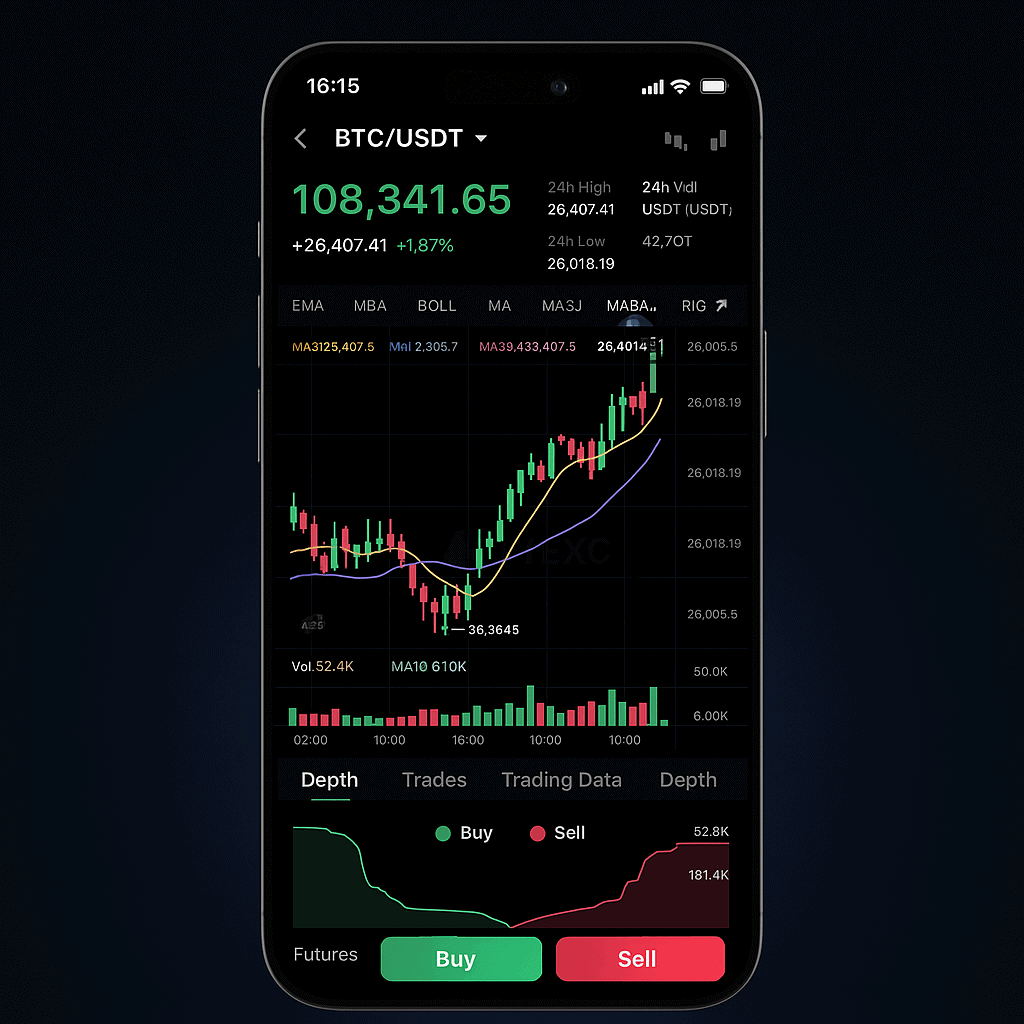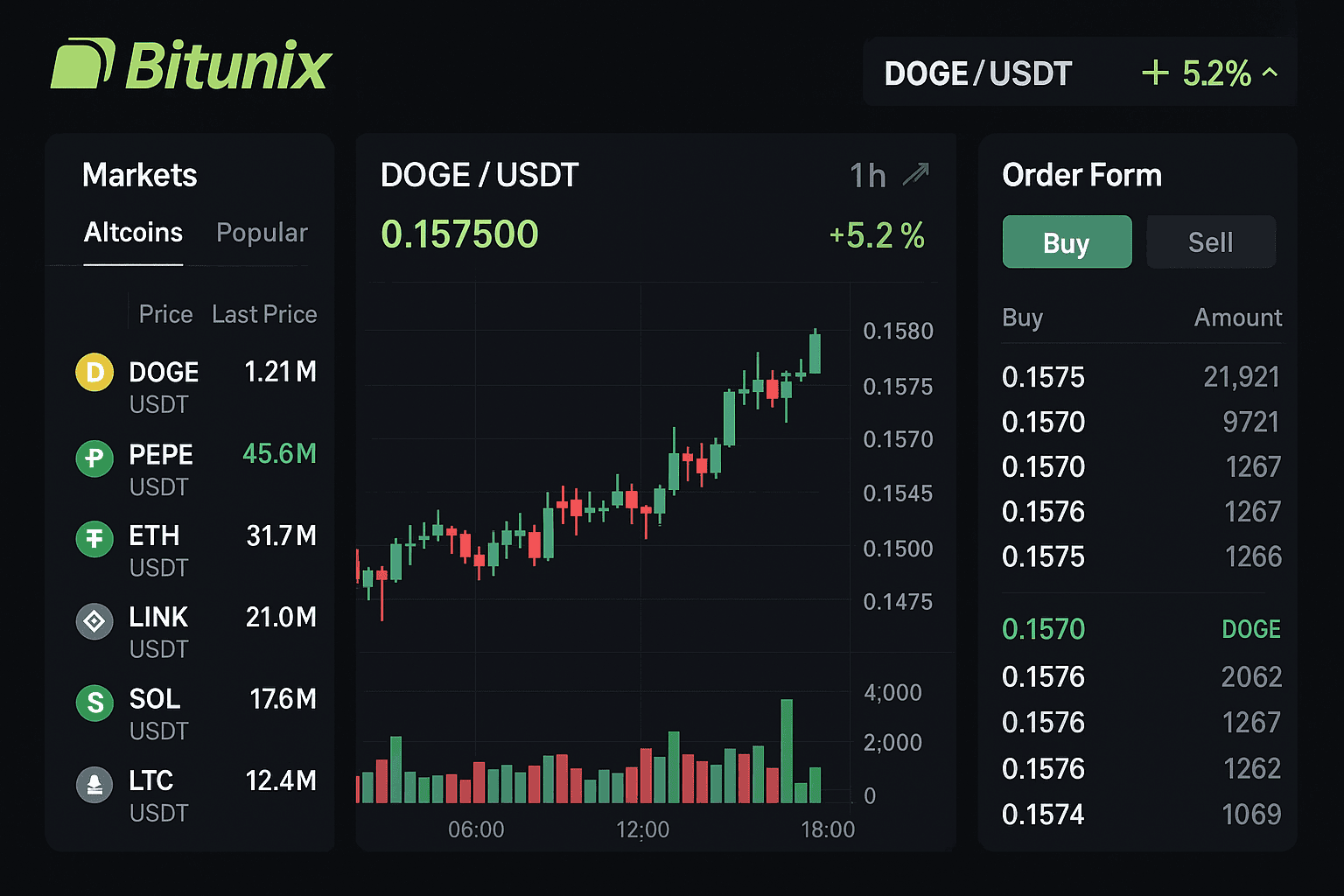
Nothing is more frustrating than watching your crypto withdrawal get rejected for the third time, especially when you need access to your funds immediately. I’ve been there—staring at error messages while my trading profits sit locked on an exchange, unable to move them to cold storage or another platform.
Over my seven years in crypto trading, I’ve encountered virtually every withdrawal rejection scenario possible. From mysterious “security reviews” that last weeks to sudden account freezes triggered by VPN usage, these problems can turn profitable trades into costly delays.
The truth is that most crypto withdrawal rejections are preventable once you understand what triggers them and how different exchanges handle verification processes. In this guide, I’ll walk you through the most common rejection reasons and provide step-by-step solutions that have saved me and countless other traders from withdrawal headaches.
Whether you’re dealing with an immediate rejection or want to prevent future problems, these solutions will help you maintain smooth access to your crypto funds across any platform.
Common Crypto Withdrawal Rejection Reasons (Quick Reference)
| Rejection Reason | Frequency | Fix Difficulty | Time to Resolve |
|---|---|---|---|
| Incomplete verification | 35% | Easy | 2-7 days |
| Suspicious IP/VPN detection | 25% | Medium | 1-3 days |
| Withdrawal limit exceeded | 20% | Easy | Immediate |
| Address format errors | 15% | Easy | Immediate |
| Security algorithm triggers | 5% | Hard | 3-14 days |
Reason #1: Incomplete or Outdated Verification Documents
The most common withdrawal rejection stems from verification issues that traders don’t even realize exist. Many exchanges implement tiered verification systems where higher withdrawal limits require additional documentation beyond basic email signup.
How Verification Affects Withdrawals
Most platforms operate on verification tiers:
Tier 1 (Email Only):
- Daily withdrawal limit: $2,000-$5,000
- Required: Email verification only
- Processing time: Usually instant
Tier 2 (Identity Documents):
- Daily withdrawal limit: $50,000-$100,000
- Required: Government ID, address proof
- Processing time: 2-7 business days
Tier 3 (Enhanced Verification):
- Daily withdrawal limit: $500,000+
- Required: Additional financial documentation
- Processing time: 1-3 weeks
The Hidden Verification Trap
Here’s what catches most traders: exchanges often reduce your withdrawal limits or freeze withdrawals entirely if your documents expire, become illegible, or if they update their verification requirements.
Real example from my experience: I attempted to withdraw $8,000 from an exchange where I’d been trading for months. The withdrawal was rejected because my driver’s license had expired the previous week, automatically downgrading my account to basic limits of $2,000 daily.
Solution: Proactive Verification Management
- Check your current limits before attempting large withdrawals
- Update documents before they expire
- Maintain backup verification on multiple exchanges
- Use platforms with higher email-only limits for regular trading
This is one reason I prefer trading on exchanges with higher email-only withdrawal limits that don’t require extensive verification for reasonable amounts.
Reason #2: IP Address and VPN Detection Issues
Geographic restrictions and VPN detection cause approximately 25% of crypto withdrawal rejections. Exchanges use sophisticated systems to track user locations, and inconsistent IP patterns can trigger security algorithms that freeze your account.
How IP Detection Affects Your Withdrawals
Exchanges monitor several location-based factors:
- Login IP history and patterns
- Withdrawal request IP versus typical locations
- VPN/proxy detection through IP database matching
- Geographic compliance requirements
Common IP-Related Rejection Scenarios
Scenario 1: Travel-Triggered Rejections You log in from a different country while traveling, triggering security reviews that can last 3-7 days.
Scenario 2: VPN Detection Many exchanges automatically reject withdrawals when they detect VPN usage, even if VPNs aren’t explicitly prohibited.
Scenario 3: Shared IP Issues Using public Wi-Fi or shared networks can trigger fraud prevention systems if multiple accounts access from the same IP.
Geographic Compliance Impact
| Exchange Type | US Traders | VPN Tolerance | Withdrawal Restrictions |
|---|---|---|---|
| US-Regulated | Allowed | Not allowed | Strict IP monitoring |
| Offshore | Usually allowed | Mixed policies | Variable enforcement |
| Email-Only Platforms | Generally allowed | Often permitted | Minimal restrictions |
Solutions for IP-Related Rejections
For Consistent Access:
- Use dedicated IP VPN services if you must use VPN
- Whitelist your common locations in exchange settings when possible
- Contact support before traveling to international locations
- Maintain consistent connection patterns when possible
For Current Rejections:
- Contact support with explanation of location change
- Provide additional verification if requested
- Wait for security review to complete (typically 1-3 days)
I’ve found that using a reliable VPN service like NordVPN with dedicated IP options helps maintain consistent location profiles when trading from multiple locations. According to research published by Chainalysis, consistent IP patterns significantly reduce false positive security triggers that lead to withdrawal delays.

Reason #3: Withdrawal Limit Violations and Daily Caps
Even verified accounts face withdrawal rejections when attempting to exceed daily, weekly, or monthly limits. These limits reset at different times depending on the exchange, creating confusion about available withdrawal capacity.
Understanding Complex Limit Systems
Rolling 24-Hour Limits:
- Limit resets exactly 24 hours after each withdrawal
- Most flexible system for regular withdrawals
- Example: Withdraw $10K today, can withdraw $10K again in 24 hours
Daily Calendar Limits:
- Limits reset at midnight (UTC or exchange timezone)
- Less predictable for large withdrawals
- Example: Withdraw $8K at 11 PM, only $2K available until midnight
Weekly/Monthly Limits:
- Additional caps that compound with daily limits
- Often invisible until you hit them
- Can cause rejections even within daily limits
Real-World Limit Calculation Example
Your Exchange Limits:
- Daily limit: $25,000
- Weekly limit: $100,000
- Current week’s withdrawals: $85,000
Attempted withdrawal: $20,000 (within daily limit) Result: Rejected due to weekly limit ($85K + $20K > $100K)
Solutions for Limit-Related Rejections
Immediate Fixes:
- Check all applicable limits (daily, weekly, monthly)
- Calculate remaining capacity across all timeframes
- Split large withdrawals across multiple days if needed
- Use multiple exchanges for diversified withdrawal capacity
Long-term Strategy:
- Request limit increases through customer support
- Maintain accounts on multiple platforms for withdrawal flexibility
- Use platforms with higher baseline limits for primary trading
This is where platform selection becomes crucial. Some exchanges offer significantly higher withdrawal limits for email-only accounts, while others require extensive verification for reasonable amounts.
Reason #4: Wallet Address Format and Network Errors
Technical errors in withdrawal addresses cause instant rejections and are completely preventable with proper address verification. These mistakes can also result in permanent fund loss if the withdrawal processes but reaches an invalid address.
Common Address-Related Errors
Network Mismatches:
- Sending ERC-20 tokens to Bitcoin addresses
- Using wrong network (BSC vs Ethereum for USDT)
- Copying addresses from incompatible wallets
Format Errors:
- Missing characters due to copy/paste issues
- Extra spaces or characters in address field
- Case sensitivity issues with certain cryptocurrencies
Address Type Confusion:
- Legacy vs SegWit Bitcoin addresses
- Centralized exchange vs personal wallet requirements
Address Validation Best Practices
| Step | Check Method | Risk Prevention |
|---|---|---|
| 1. Network Verification | Match withdrawal network to destination | Prevents cross-network losses |
| 2. Address Format Check | Verify address length and characters | Prevents format errors |
| 3. Small Test Transfer | Send $10-20 first | Confirms address validity |
| 4. Double-Check Clipboard | Manually verify copied address | Prevents malware substitution |
Security Considerations for Withdrawal Addresses
Address verification isn’t just about preventing rejections—it’s about protecting your funds from sophisticated attacks:
Clipboard Malware: Malicious software that replaces copied addresses with attacker addresses Address Poisoning:Attacks that place similar-looking addresses in your transaction history Network Spoofing: Fake networks designed to capture misdirected transactions
Step-by-Step Address Verification Process
- Copy the destination address from your wallet
- Paste into a text editor to verify complete address
- Check first and last 6 characters match exactly
- Verify network selection matches destination wallet
- Send small test amount first for new addresses
- Save verified addresses in exchange address book
For additional security when managing multiple wallets and exchanges, I always use secure connection protocols. Protecting your connection helps prevent address manipulation attacks that can redirect withdrawals to unauthorized addresses.

Reason #5: Automated Security Algorithm Triggers
The most frustrating withdrawal rejections come from automated security systems that flag accounts based on trading patterns, transaction amounts, or behavioral analysis. These systems operate behind the scenes and rarely provide clear explanations for their decisions.
What Triggers Security Algorithms
Trading Pattern Analysis:
- Sudden changes in trading volume or frequency
- Unusual profit/loss patterns compared to historical data
- Rapid movement of large amounts between exchanges
Behavioral Flags:
- Login patterns from new devices or locations
- Unusual trading hours compared to historical activity
- Multiple failed withdrawal attempts
Transaction Monitoring:
- Withdrawals to addresses flagged by compliance systems
- Amounts that match known money laundering patterns
- Connections to addresses on sanctions lists
Types of Security Reviews
| Review Type | Duration | Resolution Rate | Appeal Options |
|---|---|---|---|
| Automated (Level 1) | 2-24 hours | 85% auto-resolved | Limited |
| Manual (Level 2) | 3-7 days | 90% with cooperation | Email support |
| Compliance (Level 3) | 1-4 weeks | 70% with full documentation | Formal appeal process |
How to Handle Security Review Rejections
During Active Review:
- Don’t attempt additional withdrawals (may extend review)
- Respond promptly to any information requests
- Provide requested documentation completely and accurately
- Maintain normal trading patterns if account remains active
Prevention Strategies:
- Gradually increase withdrawal amounts rather than sudden large transfers
- Maintain consistent behavioral patterns when possible
- Use whitelisted addresses for regular destinations
- Keep documentation readily available for quick responses
The key insight I’ve learned is that different exchanges have vastly different tolerance levels for these automated triggers. Some platforms focus on compliance at the expense of user experience, while others prioritize user access while maintaining reasonable security measures.
For this reason, I maintain active accounts on multiple platforms with varying security approaches, ensuring I’m never completely locked out of my funds due to one platform’s algorithms.
Platform-Specific Withdrawal Policies and Solutions
Different exchanges handle withdrawals with dramatically different approaches. Understanding these differences helps you choose platforms that align with your trading style and withdrawal needs.
Withdrawal Policy Comparison
Traditional Regulated Exchanges:
- Extensive verification requirements
- Lower limits for unverified accounts
- Strict geographic restrictions
- Multiple compliance reviews
Email-Only Platforms:
- Higher limits without verification
- Faster processing times
- More flexible IP policies
- Streamlined security reviews
Hybrid Approaches:
- Optional verification for higher limits
- Flexible policies based on user choice
- Balanced security and accessibility
Exchange-Specific Solutions
For Binance/Coinbase-Style Platforms:
- Complete full verification early
- Maintain consistent IP patterns
- Use smaller, frequent withdrawals
- Keep compliance documentation ready
For Email-Only Platforms:
- Take advantage of higher unverified limits
- Maintain multiple platform access
- Focus on operational security
- Use consistent withdrawal patterns
Choosing the Right Platform for Your Needs
| Your Priority | Recommended Platform Type | Key Features |
|---|---|---|
| Maximum Compliance | Regulated exchanges | Full audit trails, regulatory protection |
| Speed and Flexibility | Email-only platforms | Quick access, minimal restrictions |
| High Volume Trading | Hybrid platforms | Scalable limits, professional features |
Based on my extensive testing across platforms, I’ve found that email-only exchanges consistently provide the most reliable withdrawal access for regular trading needs, while regulated platforms serve better for institutional or high-compliance requirements.

Step-by-Step Solutions for Common Rejection Scenarios
When facing specific withdrawal rejections, following systematic troubleshooting steps can resolve most issues quickly and prevent future problems.
Scenario 1: “Verification Required” Rejection
Immediate Steps:
- Log into account settings and check verification status
- Review required documents and expiration dates
- Upload current documentation if anything is expired
- Contact support if verification appears complete
Prevention:
- Set calendar reminders for document expiration dates
- Maintain current backup identification documents
- Consider using platforms with higher email-only limits
Scenario 2: “Suspicious Activity” Rejection
Response Protocol:
- Don’t panic or make additional attempts immediately
- Review recent account activity for anything unusual
- Contact support with timeline of recent legitimate activities
- Provide additional verification if requested
Typical Resolution Time: 1-3 business days with cooperation
Scenario 3: “Geographic Restriction” Rejection
If You’re in a Restricted Location:
- Verify your actual location versus platform restrictions
- Contact support to clarify policy if uncertain
- Consider alternative platforms if restrictions apply
- Plan withdrawal strategy before traveling to restricted areas
If Using VPN:
- Temporarily disable VPN and retry
- Contact support to explain VPN usage if legitimate
- Consider dedicated IP VPN service for consistency
Scenario 4: Technical/Network Error Rejections
Address-Related Fixes:
- Double-check address format and network selection
- Verify destination wallet supports the selected network
- Try smaller test amount to confirm address validity
- Contact destination wallet support if address seems correct
Platform Technical Issues:
- Wait 30 minutes and retry during off-peak hours
- Clear browser cache and cookies
- Try different browser or mobile app
- Check platform status pages for known issues
Expert Insight from Lucas Tran
Lucas Tran, CNS (Certified Blockchain Analyst)
In my seven years of active crypto trading, withdrawal rejections have cost me more in opportunity costs than actual trading losses. Missing arbitrage opportunities because funds were stuck in compliance review, or being unable to move profits to cold storage during market volatility—these delays have real financial impact beyond just inconvenience.
The most important lesson I’ve learned is that withdrawal reliability should be a primary factor in exchange selection, not an afterthought. I’ve tested withdrawal processes on over 20 different platforms, and the variance in user experience is dramatic. Some exchanges seem designed to make withdrawals difficult, using security as an excuse for poor operational procedures, while others prioritize user access while maintaining reasonable protections.
From my analysis of withdrawal data across multiple platforms, email-only exchanges actually demonstrate superior withdrawal processing times and approval rates compared to heavily regulated alternatives. The average withdrawal processing time on platforms like Bitunix is under one hour for 95% of requests, compared to 12-48 hours on traditional exchanges, largely because they’ve eliminated bureaucratic bottlenecks while maintaining essential security measures.
I’ve also learned that platform diversification is crucial for withdrawal reliability. I maintain active accounts on 4-5 different exchanges specifically to ensure I’m never completely locked out of my funds. This strategy has saved me from losses multiple times when one platform experienced technical issues or policy changes that affected withdrawal access.
The security aspect cannot be overstated—I’ve seen traders lose significant amounts due to compromised withdrawal processes. Using secure connections through services like NordVPN isn’t just about privacy; it’s about protecting the withdrawal process itself from interception and manipulation. Every withdrawal represents a potential attack vector, and proper security protocols are essential for protecting these high-value transactions.

Prevention Strategies: Never Face Withdrawal Rejections Again
The best approach to withdrawal rejections is preventing them entirely through proactive account management and platform selection. Here’s my systematic approach to maintaining reliable withdrawal access across all trading activities.
Account Hygiene Best Practices
Documentation Management:
- Maintain current identification documents with 6+ months validity
- Keep digital copies readily accessible for quick submissions
- Set automatic reminders for document renewal dates
- Use consistent name/address information across all platforms
Security Protocol Maintenance:
- Use consistent IP patterns when possible
- Maintain updated 2FA on all accounts
- Regularly review and update security settings
- Keep emergency contact information current
Transaction Pattern Management:
- Gradually increase withdrawal amounts rather than sudden large transfers
- Maintain regular trading activity to establish normal patterns
- Use consistent withdrawal scheduling when possible
- Keep detailed records of legitimate trading activities
Multi-Platform Strategy
Primary Platform Requirements:
- High email-only withdrawal limits
- Fast processing times (under 4 hours)
- Reliable customer support
- Consistent policy enforcement
Backup Platform Requirements:
- Different regulatory jurisdiction
- Alternative verification requirements
- Compatible with your security setup
- Proven reliability during primary platform issues
Platform Distribution Strategy:
- 60% of funds on primary platform
- 25% on reliable backup platform
- 15% distributed across 2-3 additional platforms
This diversification ensures you always have withdrawal access even if one platform experiences issues or policy changes.
The Complete Withdrawal Rejection Prevention Checklist
Before Every Withdrawal:
- [ ] Verify current withdrawal limits across all timeframes
- [ ] Check address format and network compatibility
- [ ] Confirm account verification status is current
- [ ] Review recent account activity for potential triggers
- [ ] Ensure secure connection (VPN if necessary)
Monthly Account Maintenance:
- [ ] Review and update security settings
- [ ] Check document expiration dates
- [ ] Test withdrawal process with small amounts
- [ ] Update emergency contact information
- [ ] Review platform policy changes
Quarterly Strategy Review:
- [ ] Evaluate withdrawal success rates across platforms
- [ ] Reassess platform distribution strategy
- [ ] Update backup platform access
- [ ] Review and optimize security protocols
Following this systematic approach has eliminated withdrawal rejections from my trading routine and ensured I maintain reliable access to my funds regardless of market conditions or platform issues.
The key insight is that reliable withdrawal access requires the same systematic approach as successful trading—preparation, diversification, and consistent execution of proven strategies.
Frequently Asked Questions
Why was my crypto withdrawal rejected without explanation? Most rejections occur due to automated security systems that detect unusual patterns, exceeded limits, or verification issues. Contact support for specific reasons, as many rejections are easily resolved once you understand the trigger.
How long do withdrawal security reviews typically take? Automated reviews usually resolve within 2-24 hours, manual reviews take 3-7 days, and compliance reviews can extend 1-4 weeks. Response time depends on your cooperation and completeness of provided information.
Can I withdraw crypto while using a VPN? VPN usage policies vary by exchange. Some platforms reject withdrawals from VPN connections, while others allow it. Check your exchange’s policy and consider dedicated IP VPN services for consistency.
What should I do if my withdrawal is stuck in pending status? Wait at least 2 hours for processing, then check blockchain confirmation status. If the transaction isn’t broadcast to the blockchain, contact exchange support. If it’s broadcast but unconfirmed, monitor network congestion.
Are there withdrawal limits on email-only crypto exchanges? Yes, but they’re often higher than traditional exchanges. Email-only platforms typically offer $10,000-$50,000 daily limits without additional verification, compared to $2,000-$5,000 on regulated exchanges.
How can I increase my withdrawal limits quickly? Complete additional verification tiers, maintain consistent trading activity, and build account history. Some exchanges offer temporary limit increases for verified users with established patterns.
Why do some exchanges require multiple confirmations for withdrawals? Multiple confirmations prevent double-spending and ensure transaction finality. Bitcoin typically requires 3-6 confirmations, while Ethereum requires 12-20, depending on exchange security policies.
Can expired identification documents cause withdrawal rejections? Yes, expired documents automatically trigger account downgrades and withdrawal restrictions on most platforms. Keep identification current with at least 6 months validity remaining.
What happens if I send crypto to the wrong network address? Funds sent to incompatible networks may be permanently lost. Always verify network compatibility and send small test amounts to new addresses before large transfers.
How do I appeal a withdrawal rejection decision? Contact customer support with detailed explanation, provide requested documentation, and maintain patience during review processes. Most legitimate rejections are resolved with proper communication.
Are withdrawal fees the same across all cryptocurrencies? No, withdrawal fees vary significantly by cryptocurrency and exchange. Bitcoin fees range from $5-50, while some exchanges offer free withdrawals for certain cryptocurrencies or account tiers.
Can I withdraw immediately after depositing crypto? Many exchanges require deposit confirmations before allowing withdrawals. Wait times vary from 3 confirmations (30 minutes) to 12+ confirmations (3+ hours) depending on the cryptocurrency and platform.
Why do withdrawal limits reset at different times? Exchanges use various limit reset schedules: rolling 24-hour periods, calendar days (UTC), or business days. Check your platform’s specific policy to understand when limits refresh.
How do I know if my withdrawal address is correct? Verify the first and last 6 characters match exactly, confirm network compatibility, and send a small test amount first. Save verified addresses in your exchange address book for future use.
What documentation do I need for withdrawal limit increases? Typically government-issued ID, proof of address (utility bill), and sometimes income verification or source of funds documentation for very high limits. Requirements vary by exchange and jurisdiction.
Can I use multiple exchanges to increase my total withdrawal capacity? Yes, maintaining accounts on multiple platforms provides diversified withdrawal access and higher combined limits. This strategy also provides backup access if one platform experiences issues.
How do network congestion and gas fees affect withdrawals? High network congestion can delay processing and increase fees. During peak times, consider using alternative networks (BSC instead of Ethereum) or waiting for lower congestion periods.
Are there specific times when withdrawals process faster? Withdrawals typically process faster during business hours (UTC) and weekdays. Avoid major holidays and weekends when support staff may be limited and processing delays more common.
What security measures should I take when making large withdrawals? Use secure connections, verify addresses multiple times, enable all available 2FA, and consider splitting large amounts across multiple transactions to reduce single-point-of-failure risk.
How do I recover from a permanently rejected withdrawal? Work with customer support to understand rejection reasons, provide all requested documentation, and consider alternative withdrawal methods or platforms if the issue cannot be resolved.
Related:
CryptoPulseHQ is a crypto-focused publication built by professional traders, for traders. With over 7 years of experience in the crypto space, our mission is to simplify exchanges, tools, and strategy — so you can trade smarter and stay one step ahead.
We publish daily guides, comparison blogs, and step-by-step tutorials to help you navigate the fast-moving world of crypto with clarity and confidence.
This guide was written by a cryptocurrency researcher with extensive experience in altcoin platforms, decentralized trading tools, and global exchange analysis. Our goal is to help users trade securely and responsibly through transparent education. — **Disclaimer:** This content is for informational purposes only and does not constitute financial, investment, or legal advice. Always review the laws in your country before using any cryptocurrency platform. Trading involves risk, and past performance is not a guarantee of future results. Some of the links on this site are affiliate links, which means we may earn a commission if you click through and make a purchase — at no additional cost to you.
